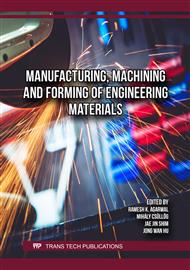[1]
H. Abyar, A. Abdullah, A.A. Shafaroud, Theoretical and experimental analysis of machining errors on small arced corners during WEDM finishing stages, Mach. Sci. Technol. 23:5 (2019) 734-757.
DOI: 10.1080/10910344.2019.1575410
Google Scholar
[2]
M. U. Farooq, M. A. Ali, Y. He, A. M. Khan, C. I. Pruncu, M. Kashif, N. Ahmed, N. Asif, Curved profiles machining of Ti6Al4V alloy through WEDM: investigations on geometrical errors, J. Mater. Res. Technol 9:6 (2020) 16186-16201.
DOI: 10.1016/j.jmrt.2020.11.067
Google Scholar
[3]
K. Mouralova, L. Benes, T. Prokes, R. Zahradnicek, J. Fries, T. Plichta, Analysis of the machinability of different types of sintered carbides with WEDM in both water and oil baths, Int. J. Adv. Manuf. Technol. 125 (2023) 2705-2715.
DOI: 10.1007/s00170-023-10913-4
Google Scholar
[4]
D. Oniszczuk-Świercz, R. Świercz, Š. Michna, Evaluation of prediction models of the microwire edm process of Inconel 718 using ANN and RSM methods, Materials 15 (2022) 8317.
DOI: 10.3390/ma15238317
Google Scholar
[5]
Ľ. Straka, M. Gombár, A. Vagaská, P. Kuchta, Efficiency Optimization of the Electroerosive Process in μ-WEDM of Steel MS1 Sintered Using DMLS Technology, Micromachines 13 (2022) 1446.
DOI: 10.3390/mi13091446
Google Scholar
[6]
S.N. Grigoriev, M.P. Kozochkin, V.D. Gurin, A.P. Malakhinsky, A.N. Porvatov, Y.A. Melnik, Display of WEDM quality indicators of heat-resistant alloy processing in acoustic emission parameters, Sensors 23:19 (2023) 8288.
DOI: 10.3390/s23198288
Google Scholar
[7]
S. Kosaraju, P. Babu Bobba, S.R. Salkuti, Optimization and microstructural studies on the machining of Inconel 600 in WEDM using untreated and cryogenically treated zinc electrodes, Materials 16 (2023) 3181.
DOI: 10.3390/ma16083181
Google Scholar
[8]
L. Straka, G. Dittrich, Influence of tool steel properties on surface quality after electrical discharge machining by wire electrode, International journal of advanced manufacturing technology 106:5-6 (2020) 1617-1632.
DOI: 10.1007/s00170-019-04708-9
Google Scholar
[9]
A. Kopytowski, R. Świercz, D. Oniszczuk-Świercz, J. Zawora, J. Kuczak, Ł. Żrodowski, Effects of a New Type of Grinding Wheel with Multi-Granular Abrasive Grains on Surface Topography Properties after Grinding of Inconel 625, Materials 16 (2023) 716.
DOI: 10.3390/ma16020716
Google Scholar
[10]
W. Ming, X. Guo, G. Zhang, S. Hu, Z. Liu, Z. Xie, S. Zhang, L. Duan, Optimization of process parameters and performance for machining Inconel 718 in renewable dielectrics, Alexandria Engineering Journal 79 (2023) 164-179.
DOI: 10.1016/j.aej.2023.07.075
Google Scholar
[11]
R. Nowicki, R. Świercz, D. Oniszczuk-Świercz, M. Rozenek, Experimental investigation of technological indicators and surface roughness of hastelloy C-22 after electrical discharge machining using POCO graphite electrodes, Materials 15 (2022) 5631.
DOI: 10.3390/ma15165631
Google Scholar
[12]
A. Panda, V. Chernobrovchenko, K. Dyadyura, L. Sukhodub, M. Kumeda, M. Behun, Selection of materials hydroxylapatite using the method of analysis of hierarchy, MM Science Journal, 6 (2023) 6472-6477.
Google Scholar
[13]
M. Rafaqat, N.A. Mufti, N. Ahmed, A.U. Rehman, A.Y. AlFaify, M.U. Farooq, M. Saleh, Hole-making in D2-Grade steel tool by electric-discharge machining through non-conventional electrodes, Processes 10 (2022) 1553.
DOI: 10.3390/pr10081553
Google Scholar
[14]
M. Rimar, J. Kizek, A. Varga, M. Fedak, G. Jablonský, The influence of hydrogen concentration in natural gas on heat flows in a thermal aggregate, MM Science Journal, 12 (2022) 6162-6168.
Google Scholar
[15]
D. Rodic, M. Gostimirovic, M. Sekulic, B. Savkovic, A. Aleksic, Study and optimization defect layer in powder mixed electrical discharge machining of titanium alloy, Processes, 11:4 (2023) 1289.
DOI: 10.3390/pr11041289
Google Scholar
[16]
J. B. Saedon, N. Jaafar, R. Jaafar, N.H. Saad, M.S. Kasim, Modeling and multi-response optimization on WEDM Ti6Al4V, Applied mechanics and materials 510 (2014) 123-129.
DOI: 10.4028/www.scientific.net/amm.510.123
Google Scholar
[17]
L. Straka, J. Pitel, I. Corny, Influence of the main technological parameters and material properties of the workpiece on the geometrical accuracy of the machined surface at WEDM, International journal of advanced manufacturing technology 115:9-10 (2021) 3065-3087.
DOI: 10.1007/s00170-021-07313-x
Google Scholar
[18]
V. Singh, A.K. Sharma, A. Goyal, K.K. Saxena, P. Negi, P.Ch.S. Rao, Electric discharge machining performance measures and optimisation: a review, Advances in Materials and Processing Technologies (2023).
DOI: 10.1080/2374068x.2023.2168775
Google Scholar
[19]
A.M. Takale, N.K. Chougule, P.H. Selmokar, M.G. Gawari, Multi-response optimization of micro-WEDM process parameters of Ti49.4-Ni50.6 shape memory alloy for orthopedic implant application, Advanced materials research 1150 (2018) 1-21.
DOI: 10.4028/www.scientific.net/amr.1150.1
Google Scholar
[20]
T. Yu, J. Zhao, Quantifying the mechanisms of keyhole pore evolutions and the role of metal-vapor condensation in laser powder bed fusion, Additive Manufacturing, 72 (2023) 103642.
DOI: 10.1016/j.addma.2023.103642
Google Scholar
[21]
A. Vagaská, M. Gombár, Ľ. Straka, selected mathematical optimization methods for solving problems of engineering practice, Energies 15 (2022) 2205.
DOI: 10.3390/en15062205
Google Scholar
[22]
G. Wang, F.A. Han, Comparative study on the surface integrity of single-step and multi-step sequential machining in electric discharge machining, Int. J. Adv. Manuf. Technol. 114 (2021) 1803-1817.
DOI: 10.1007/s00170-021-06947-1
Google Scholar
[23]
J. Wang, J.A. Sanchez, B. Izquierdo, K.T. Shabarinathan, K. Senthilkumar, N. Kathiravan, R.M. Udhayachandran, Investigation of enhancing EDM machining performance of INCONEL alloy using composite electrodes, Mater. Res. Express 11:1 (2024) 016513.
DOI: 10.1088/2053-1591/ad1b09/v2/response1
Google Scholar
[24]
Wire EDM Manual for electrical discharge machine Agiecharmilles Cut E350. https://www.scribd.com/document/527969717/Agiecharmilles-Cut-e350-600-en-1 (accessed on 10 February 2025).
Google Scholar



